Brutalist Bus Shelters of Goulburn
Anyone born and raised in Canberra knows well of the brutalist concrete bus shelters that hide around every corner. These great beasts keep waiting travellers safe from the weather and have become a vibrant canvas for artists both professional and otherwise. Designed by Clem Cummings at the request of the local government in 1974, these shelters have become the mascot of Canberra thanks in part to their iconic design and artworks by Newcastle based artist Trevor Dicksinson.
Since the 1970s, Canberra residents have spent many a wet day sheltering within these behemoths, a haven for travellers waiting in the brutal winds and rain; a little eco-system all of their own.
So, how did these bus shelters, an integral part of everyday life in Canberra, make their way to our Goulburn streets?
The Mystery of Goulburn's Shelters.
As of 2024, there are a total of seven brutalist bus shelters of a similar design in Goulburn. Five of these are the Canberra Clem Cummings design while two are distinctly not – a unique mystery just for Goulburn.

Verner St, Goulburn. Photo by Jack Miller, 2024.
But the mystery and intrigue of these shelters continues further. Of the original Cummings stops one of them does not have the traditional yellow and orange colour scheme. The accents are painted a pale green and in fact the concrete has been left raw and white, as if it was delivered straight from the manufacturer. All shelters in Canberra include a single bench for commuters to sit on, but four of five Goulburn stops have two benches taking up the entire back. And perhaps most uniquely, every Goulburn Cummings stop still features intact polycarbonate windows, something not seen in the Canberra shelters at all.
Cummings’ bus shelters have been known to wander over the years, making their way to Maitland, Sydney, and even as far as the Sunshine Coast! But in all of these areas the shelters are a rare treat, lost beasts who have settled far from home. In Goulburn however, it seems as though they moved as one. A planned migration of a family who have settled and made their home here.
It is high time the secret of these mighty beasts be revealed...
The Modern Movement and Brutalist Architecture.
The shelters are a divisive bunch with many passionate critics. But for every passionate critic there is a true lover who admires the simplicity of their design.
The shelters come from a design of architecture popularised in the mid 20th Century called brutalism – which itself was born from the earlier modern movement. The modern movement developed in the 20th Century and is notable for geometric cubist forms that appear as though they could have been made by machines. The brutalist movement expanded upon this geometric and “machine-made” aesthetic with reflections from the Great Depression, pushing architects to think outside the box of traditional aesthetics and to build structures that were affordable and utilitarian in nature (HeriCon, 2013).
There are several Modern Movement buildings in Goulburn:
- Lilac Time Hall, now Lilac City Cinema.
- Goulburn Teachers' College, now the NSW Police Academy.
- Goulburn Workers Club.
- Goulburn Central Motor Lodge.
Clem Cummings.
There are many questions surrounding the existence of these shelters in Goulburn, but the most important question, that of their mysterious origin, has a clear answer. As mentioned earlier, Clem Cummings (1934 – 1997) was a Canberra-based architect who was commissioned by the National Capital Development Commission in 1974 to design bus shelters for Canberra bus routes.
Cummings was born in Cairns, Queensland, and moved to Canberra in 1953 to study at Duntroon, where he graduated in 1955. Cummings then studied architecture at Sydney University, graduating with honours in 1962. For the next few years he worked with the public service in the Department of Works before moving to a private firm, Dirk Bolt Architects and Town Planners, until finally in 1971 he opened his own practice C.G. Cummings, Architect (ArchivesACT, 2016).
The site of Canberra as the nation's capital was agreed upon in 1913, but due to WWI, Federal Government would not actually sit in the capital until Parliament House had finished construction in 1927. It would be a couple more decades until more residential areas of Canberra were further developed, with the establishment of the National Capital Development Commission (NCDC) in 1958 (National Capital Authority, n.d). Canberra was further developed during the 1960s and 1970s, and it is upon this background where Clem Cummings is commissioned to design bus shelters for the burgeoning city.
Canberra's Resilient Shelters.
The first design Cummings handed in would cost $2300 each (just over $22,000 when adjusted for inflation). The design was immediately rejected, with the Commission suggesting that Cummings redesign his creation in a way that could reduce the cost by almost half. After adjusting the designs, Cummings returned with a new quote of $2800 per shelter and explained that his design was “resistant to vandalism”. The Commission folded and accepted the $2800 design (Warden, 2016). By 1993, there were 477 Cummings shelters in use in Canberra (ArchivesACT, 2015).

New Shelters for ACT Bus Stops. The Canberra Times, 1975.
Cummings’ design is an expert example of brutalist architecture, with his use of concrete as the primary material and the simplistic but functional design. The simplicity also aids in another unique feature of these stops, that being their ability to be relocated in whole when needed (Warden, 2016). The solid design also made them nearly indestructible to most types of vandalism, save for the polycarbonate windows. The windows, the weakest point of the design, were easy to be pushed out or burned, and eventually replacing them became too difficult and the ACT Government gave up and ceased replacement of the windows (ArchivesACT, 2016).
Since the late 1990s artists have been commissioned to adorn the shelters in artworks, mostly along the inside area but sometimes painting the outside as well. Their classic orange and cream colour scheme has become something of a mascot for the town, on par with other iconic city mascots like the red telephone box of London and the yellow taxis of New York (Coleman, 2022).
A recent surge in popularity, including merchandise ranging from mugs, puzzles, and fridge magnets, can be drawn back to Newcastle-based artist Trevor Dickinson. Dickinson spent 6 years photographing every shelter in Canberra and then selected his favourite ones to illustrate in his distinctive style.
Hunting in the Wild.
While designed and born in Canberra, many of Cummings’ stops have spread their wings and moved to other parts of Australia. There are shelters to be found in Goulburn (of course), Sydney, Maitland, Tallong, Burradoo, and even Surfer’s Paradise in Queensland!
It is unclear how many of these stops made their way to other towns, with many appearing seemingly overnight. Even Action buses of Canberra were unaware that several stops had made their way to Goulburn. The earliest confirmed date of a shelter in Goulburn is that of the shelter by the TAFE in Verner St.
There are a pair of shelters in Surfer’s Paradise that have been uniquely transformed into a set of public toilets. A page from the council minutes in December of 1991 seems to capture the discussions around the implementation of this unique toilet block and seems to indicate that the pair of shelters may have been directly commissioned from Cummings or the manufacturer directly. A fitting tribute to the state that birthed the architect.
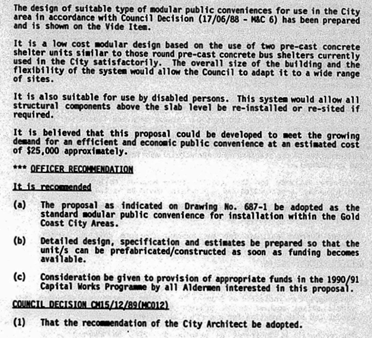
Gold Coast City Council meeting minutes, 13 December 1991.
Tallong train station has a shelter with a unique cream and blue palette (see below). The shelter at Tallong was installed around April in 1994 at the train station, which is confirmed by a humorous local news article. When the shelter was installed, it was somehow installed on the wrong side of the fence – rendering it difficult to use, at best. Local commentators joked that the fence was there to protect the shelter from vandals (The District Times, 1994).

Left: the view looking south along the platforms at (Madden, 2004). Right: An unfortunately placed fence (The District Times, 1994).
The final clue to the puzzle of identifying the containment breach of these mighty beasts comes from a 1982 Canberra Times article. Melcoco, the manufacturers of the Cummings bus shelters, had three leftover shelters sitting in their yard in Queanbeyan, NSW, with nowhere to place them in the city. The three stops were offered to Queanbeyan City Council but their final destination is unknown.

We wonder where these shelters ended up? (The Canberra Times, 1982).
There were several series of Cummings shelters made, though it is hard to discern between the last four runs. The first run of shelters had seats with backs which were removed from future models. All Goulburn shelters have backless seats, indicating that they are a series 2, 3, 4, or 5 shelter – produced between 1976 and 1980. Cummings bus shelters are meant to have a single bench seat positioned against the back of the shelter, however all but one of the Goulburn shelters have two seats installed.
It is curious to note that the one shelter with a single seat, the one on the corner of Victoria and Kinghorne Streets, has a few other interesting quirks as well. Firstly, the concrete is raw (not painted in the classic cream) and the accent colours are green instead of orange. The last titbit to know about this shelter is that it is in fact the second Cummings shelter to sit in this location – as the first one was destroyed by a car accident in May 1992. The driver was ordered by Goulburn City Council to pay the replacement cost of the shelter, which they would presumably be buying directly from the manufacturer.

Victoria St, Goulburn (Miller, 2024).
This information, in conjunction with the knowledge that the shelters were not an instant hit, gives some indication of how they could have escaped containment – either through direct commissioning or sale of surplus. However, all of these are still theories as there is still much mystery surrounding their migration patterns.
A Goulburn Special.
So, that is something of an answer for the Cummings shelters – or at least something to put a pin in and revisit later. But this does not answer anything about the two shelters that are distinctly not a Cummings design.

Left: Sydney Road, Goulburn (Miller, 2024). Right: Apex Circuit, Goulburn (Miller, 2024).
The above shelters, located on Sydney Road and within the Clinton Villas respectively, are a bit of an oddity. Compared to Cummings’ design they have thinner walls and are rather more squat. The Sydney Road shelter is especially perplexing with its sharp, angular windows.
A callout to the community requesting information on these shelters brought in hundreds of comments from people discussing their memories of waiting in the shelters as well as those who were involved in their construction. However, knowing that Cummings shelters were made by Melcoco in Queanbeyan, it was quite a puzzling moment to see people insisting that the shelters had been manufactured by a company called Manacon Tanks in Goulburn.
This puzzle was solved by the timely visitation by Tony Lamarra to Goulburn Mulwaree Library. Mr Lamarra has been a prominent citizen of Goulburn since the 1950s, having been involved with the Lions Club, and serving the Goulburn Council for 26 years.
Tony sat down at a coffee table at the back of the Library and pulled out a newspaper article (see below) and placed it down on the table. He explained his involvement in local council and the Lions Club – which included the installation of a bus shelter in the Smith Family Village, now Clinton Villas. In that moment everything fit in to place, as Lamarra explained that he was inspired by the tanks produced by Manacon and requested a friend who worked there to make a shelter. These $1000 shelters are the two pictured above.
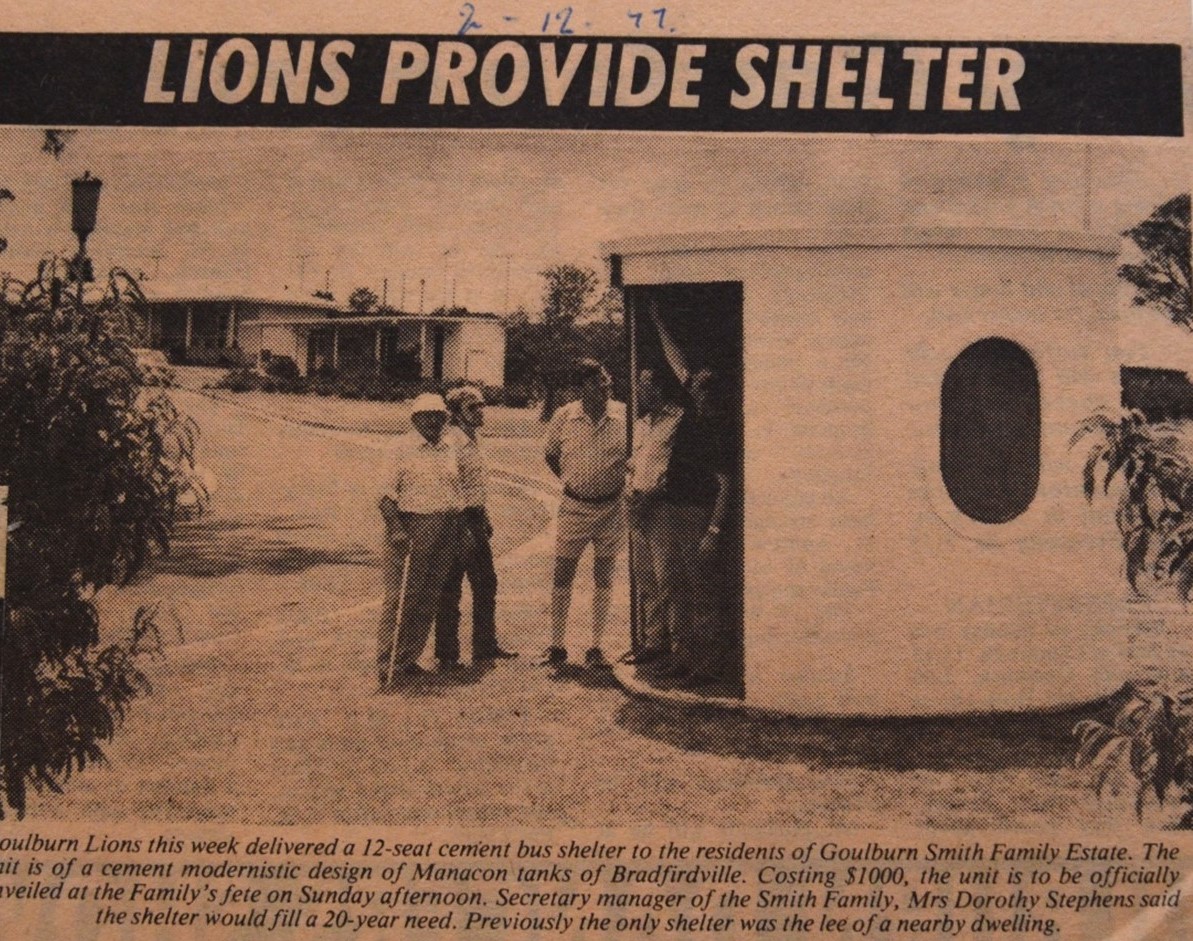
Unveiling of the Lions Club bus shelter on Apex Circuit. Image courtesy of Tony Lamarra (Goulburn Post, 1977).
Installed by the Lions Club in 1977, these shelters share a distinct likeness with the Cummings shelter that is still a mystery. Lamarra was not familiar with Cummings’ work and it has proven difficult to contact anyone who worked for Manacon tanks at the time. Regardless, these unique shelters can only be found in Goulburn and have a strongly local story connected to one of Goulburn’s most famous faces of the twentieth and twenty-first century!
After the successful installation of the first shelter in the Smith Family Village, Mr Lamarra requested the City Engineer to inspect the shelter and consider using the design elsewhere within council.

Goulburn City Council meeting minutes, 6 December 1977.
On 17 January the following year, council discussed the installation of another bus shelter at the junction near Gorman Road. Gorman Road comes off Sydney road, and one can only wonder whether the shelter sitting all by itself on the edge of town on Sydney road is the shelter mentioned in the minutes or an earlier prototype long forgotten.

Goulburn City Council meeting minutes, 17 January 1978.
What's so Special?
And with that the quest for the mystery of these shelters reaches an end. The mystery of the two unique shelters solved, as living evidence to the impact of Tony Lamarra on the town and his passion for his community. The mystery of the Cummings shelters continues. With no evidence (yet!) to how they made their way to Goulburn, one can only assume that they grew a fine pair of legs and walked their way here!
Though, that is not to say that there is not more to be gleaned from both the social and architectural significance of these shelters.
These shelters have become a recognised and loved part of the Canberra vista, and are also much beloved within Goulburn as well. The presence of these shelters in Goulburn highlights the relationship that we have with Canberra. A capital city so close by, and one which many people in Goulburn have connection with. There is a chance for some of the this love to be shared with Goulburn, as many people in Canberra (even the artist Trevor Dickinson) are unaware of the shelters that are present in Goulburn.
What pieces of this puzzle do you have?
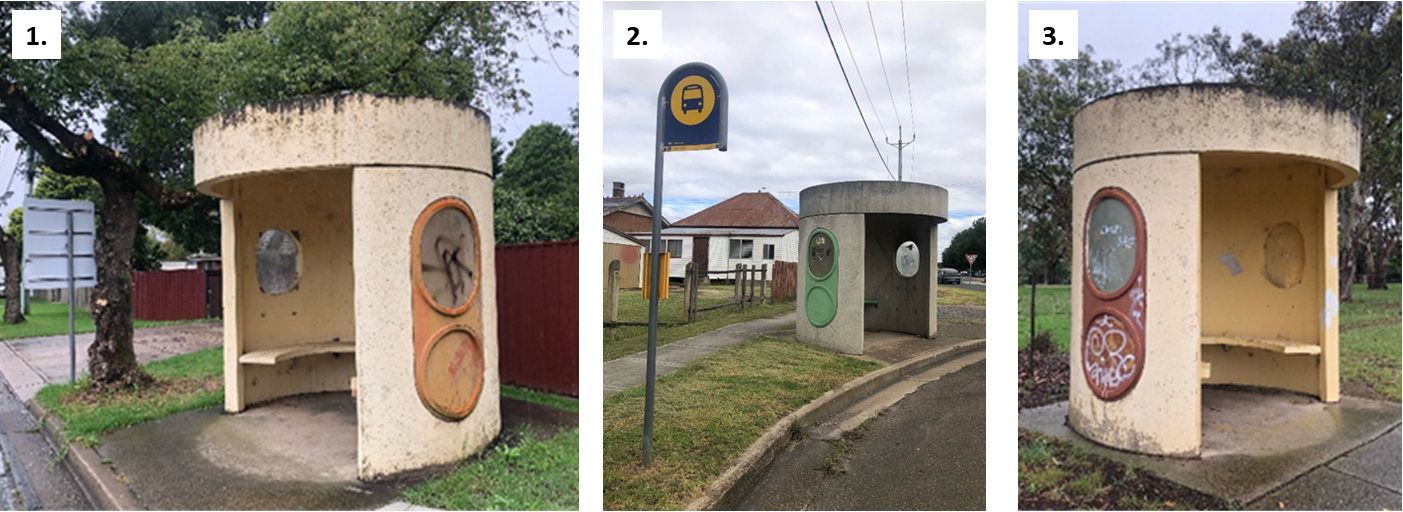
1. Albert and Kinghorne St.
2. Victoria St. The original shelter on Victoria St. was destroyed in May 1992 following a car accident. The driver was ordered by Council to pay for a replacement shelter in the same style. The position of the shelter was shifted slightly between 2009 and 2020.
3. Verner St.
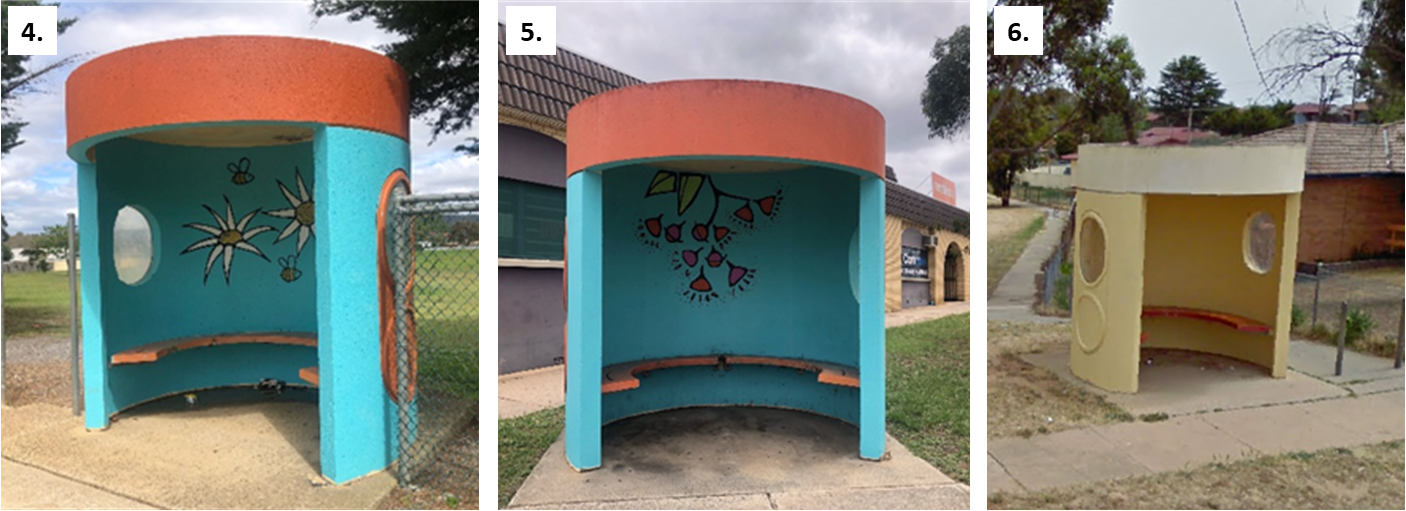
4. Reign and Nichols St.
5. Ross St. at Bradfordville Medical Centre.
6. Howard Bvd. Removed.
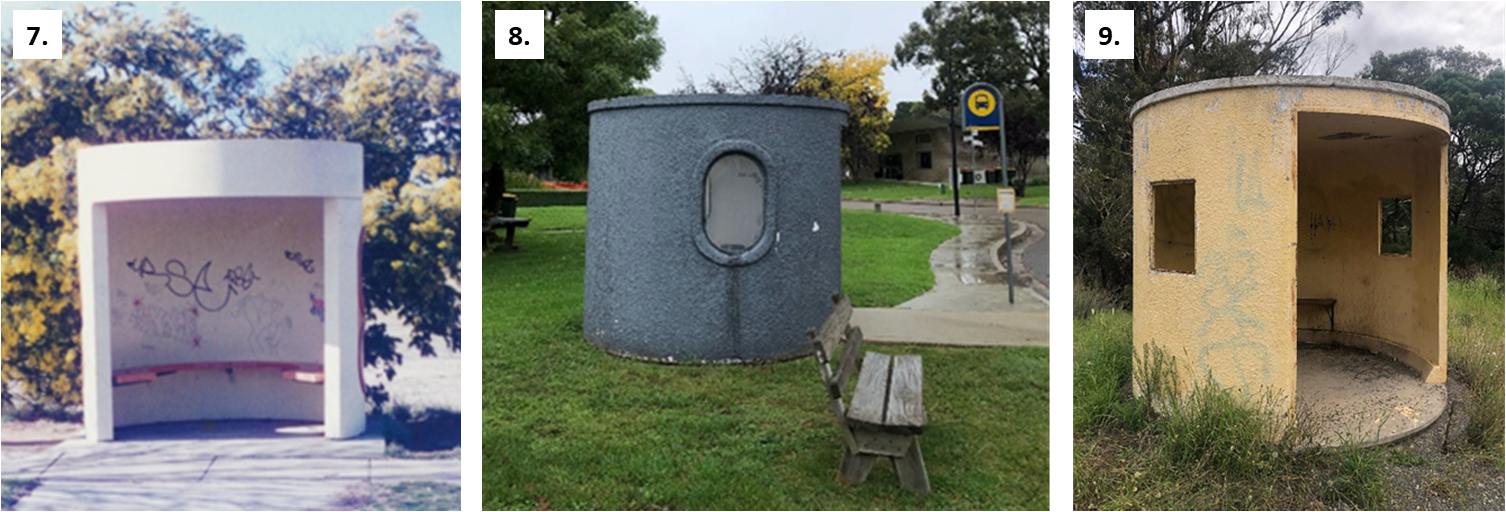
7. McDermott Dr. Removed.
8. Clinton Villas. Lions Club shelter, made locally from a Manacon tank.
9. Sydney Rd. Possible prototype of Lions Club shelter, made locally from a Manacon tank.
References.
ArchivesACT (2015). Previous find of the month The Urban Environment Enhanced, ArchivesACT. Available at: https://www.archives.act.gov.au/find_of_the_month/2015/february/previous-find-of-the-month-22015-page-1 (Accessed: 06 June 2024).
ArchivesACT (2016). Previous find of the month Concrete Monstrosities or Canberra Icons?, ArchivesACT. Available at: https://www.archives.act.gov.au/find_of_the_month/2016/may/previous-find-of-the-month-52016-page-1 (Accessed: 06 June 2024).
The Canberra Times (1975). New shelters for ACT bus stops. 21 March pg. 8.
The Canberra Times (1982). By the way . 17 October pg. 3. Available at: http://nla.gov.au/nla.news-article116476123 (Accessed: 12 Jun 2024).
Coleman, J. (2022). Canberra’s round bus shelters are beloved icons, so why don’t we make them anymore?, Riotact . Available at: https://the-riotact.com/canberras-round-bus-shelters-are-beloved-icons-so-why-dont-we-make-them-anymore/579997 (Accessed: 06 June 2024).
Dickinson, T. (2020). Beautiful Bus Shelters of Canberra. Newcastle Productions.
The District Times (1994). Shelter from the storm. 20 April 1994.
Gold Coast City Council (1991). Meeting minutes. Page 9.
Goulburn City Council (1977; 1978). Meeting minutes.
The Goulburn Post (1977). Lions Provide Shelter. 2 December 1977.
HeriCon (2013). The Modern Movement in New South Wales: A Thematic Study and Survey of Places. North Ryde, NSW.
Madden, W (2004). The view looking south along the platforms.
Miller, J (2024). Photographs of Goulburn Bus Shelters.
Warden, I. (2016). Gang-gang. Our iconic bus shelters: ‘concrete monstrosities?’, The Age. Available at: https://www.theage.com.au/national/act/ganggang-our-iconic-bus-shelters-concrete-monstrosities-20160504-golqlu.html (Accessed: 06 June 2024).
